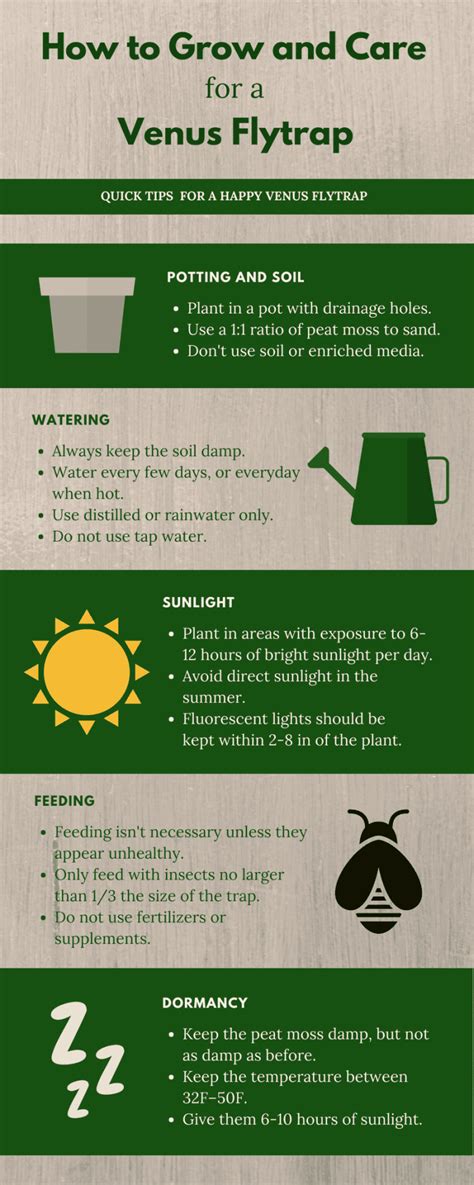How To Care For a Venus Flytrap: A Complete Guide
The Venus flytrap, Dionaea muscipula, is a captivating carnivorous plant known for its unique trapping mechanism. Owning one is a rewarding experience, but requires understanding its specific needs. This guide provides comprehensive instructions on how to care for your Venus flytrap, ensuring its long and healthy life.
Understanding Your Venus Flytrap's Needs
Before diving into specifics, it’s crucial to understand that Venus flytraps are not your average houseplant. They thrive in specific conditions mimicking their natural bog habitat. Ignoring these needs will quickly lead to a sickly or dying plant. Key factors include:
- Sunlight: Plenty of direct sunlight is vital. Aim for at least 4-6 hours of direct sunlight daily. A south-facing window is ideal, but supplemental grow lights may be necessary during winter months or in areas with limited sunlight.
- Water: Use pure, distilled, or rainwater. Tap water contains minerals that are toxic to Venus flytraps. Keep the soil consistently moist, but not soggy. Never let the plant sit in standing water. The pot should have drainage holes. Bottom watering is recommended.
- Soil: Use a specialized carnivorous plant mix. Standard potting soil is too rich and will harm the plant. A mix of peat moss and perlite is ideal, providing excellent drainage and acidity.
- Dormancy: Venus flytraps experience a period of dormancy during the fall and winter. During this time, growth slows significantly, and the plant may appear less vibrant. This is a natural process and is essential for the plant's health. Reduce watering during dormancy.
- Feeding: While they are carnivorous, overfeeding is detrimental. Only feed your Venus flytrap insects occasionally – perhaps once a month – and only if the trap is fully open. Avoid feeding it dead insects or human food. The plant can obtain most of its nutrients from the soil.
- Temperature & Humidity: Venus flytraps prefer temperatures between 65-75°F (18-24°C). Higher humidity helps, but isn't strictly necessary.
Essential Care Tips for a Thriving Venus Flytrap
Watering Techniques:
- Bottom Watering: The most effective method. Place the pot in a tray of water, allowing the soil to absorb moisture from the bottom up. This prevents overwatering and keeps the roots consistently moist.
Feeding Your Flytrap:
- Live Insects Only: Feed only live insects, no larger than one-third the size of the trap. Avoid feeding too frequently. The plant will obtain most of its nutrients from the soil.
Repotting:
- Repot every 1-2 years: As your Venus flytrap grows, it will need to be repotted into a larger container using fresh carnivorous plant mix. Do this in the spring, before the growing season.
Dealing with Pests and Diseases:
- Inspect Regularly: Check for signs of pests like aphids or mealybugs. If detected, use insecticidal soap to control them. Root rot is a common issue caused by overwatering. Ensure proper drainage and avoid overwatering.
Common Mistakes to Avoid
- Using Tap Water: This is a major killer of Venus flytraps due to the mineral content.
- Overfeeding: Too much food can harm or even kill the plant.
- Using Incorrect Soil: Standard potting soil is too nutrient-rich and will harm your plant.
- Insufficient Sunlight: Lack of sunlight will result in weak growth and poor trapping ability.
- Ignoring Dormancy: Disrupting the dormancy cycle can weaken the plant significantly.
By following these guidelines, you can ensure your Venus flytrap thrives and brings years of enjoyment. Remember, patience and attention to detail are key to successfully cultivating this fascinating plant. Remember to research further to find more specific tips and tricks on this rewarding hobby!
